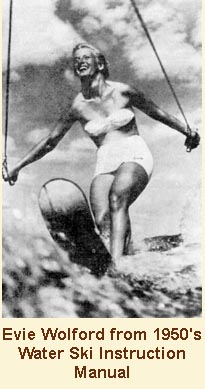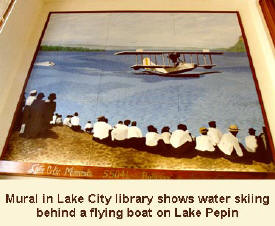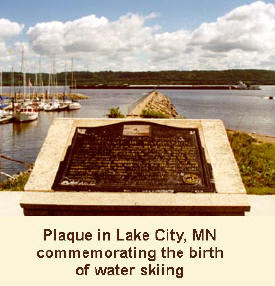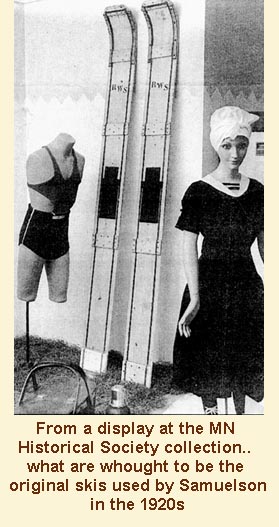Minnesota – Birthplace of Water Skiing
by Andreas Jordahl Rhude
Water skiing seems so natural to those involved with boats and water activities. Who would think that this sport would have to be “invented?” That’s exactly what happened in the summer of 1922. Lake City, Minnesota resident, Ralph Samuelson, slapped a pair of wooden boards to his feet and was pulled out of the water behind a power boat. Lo and behold – a new sport was discovered.
 It wasn’t quite that simple, however. Eighteen-year-old Ralph got the notion in his head that if one could ski on snow, why could one not also ski on water? An enterprising Scandinavian idea! So he started experimenting. His first attempt at skiing on the water’s surface was with snow skis, believe it or not! Failure ensued. He changed tactics.
It wasn’t quite that simple, however. Eighteen-year-old Ralph got the notion in his head that if one could ski on snow, why could one not also ski on water? An enterprising Scandinavian idea! So he started experimenting. His first attempt at skiing on the water’s surface was with snow skis, believe it or not! Failure ensued. He changed tactics.
His success came after he steam-bent the ends of two nine inch by eight foot boards to form skis with curved tips. This, like a snow ski, would keep the front of the planks from digging in. Viola! It worked! The world’s first water skier plied the surfaces of Lake Pepin at Lake City on the second of July, 1922. He was pulled by a 24-foot boat
powered by a 24 horsepower inboard motor. For the next fifteen years, Samuelson put on skiing exhibitions at Lake City and other areas, including Florida.
Samuelson, the consummate pioneer, was the first to ski- jump in 1925. He covered a half-submerged raft with lard from a local Lake City butcher shop after several failed attempts without the lubricant. The same summer, he was the first to fly on skis. He was pulled on the surface and then above the water behind a restored World War I Curtiss flying boat on Lake Pepin at a speed of 80 MPH!
 Mr. Samuelson skied his final run in 1937. While helping to construct a boat livery in Florida that year, he broke his back when a construction failure toppled the roof onto him. He eventually settled down as a turkey farmer at Pine Island, Minnesota, succumbing to cancer in 1977.
Mr. Samuelson skied his final run in 1937. While helping to construct a boat livery in Florida that year, he broke his back when a construction failure toppled the roof onto him. He eventually settled down as a turkey farmer at Pine Island, Minnesota, succumbing to cancer in 1977.
For many decades, there was controversy as to the originator of the sport. One camp credited the French along the Riviera as the first. Fred Waller of Long Island, New York patented “Akwa Skees” in 1924 and was also credited with inventing water skiing. It took years before the truth was brought to light and accepted. The American Water Ski Association officially recognized Lake City as the birthplace of water skiing in 1966, attributing Samuelson with the founding of the sport.
Ralph never gave it a second thought that he did anything extraordinary until the 1960s. He was just having fun. It wasn’t until a St. Paul reporter stumbled upon his story in 1963 that the research into the true origins of the sport took place. He attending the ground breaking ceremony for the new Water Ski Hall of Fame in Winter Haven, Florida in 1977, where he was honored. As soon as he returned to Minnesota, his cancer got the better of him and he passed away.
 The American Water Ski Association was established in New Jersey in 1939. The first National Water Ski Tournament took place that year at Jones Beach, New York with Bruce Parker taking home the trophy.
The American Water Ski Association was established in New Jersey in 1939. The first National Water Ski Tournament took place that year at Jones Beach, New York with Bruce Parker taking home the trophy.
Skiing on the water was becoming quite popular by the fifties. Capitalizing on this surge were companies like Evinrude, the outboard motor manufacturer. What a good ploy to market their engines. They published their “How To Book of Water Skiing several times during those years. It discussed the equipment needed from a boat and motor, Evinrude of course, to skis and tow ropes. It gave basic instructions with illustrations for the beginner right up through the expert.
On the 26th of May, 1953, Mr. Frankie Beddor set the world’s record for non-stop distance covered on water skis. He skied from Memphis to Greenville on the Mighty Mississippi, a distance of 229 miles. The elapsed time was 9 hours and 10 minutes. He skimmed over the water on Ski Antics skis, manufactured by the Nor-Craft Marine Division of Northwest Plastic Company, St. Paul (for more on Nor-Craft Boats, see the June 2000 issue of The BoatHouse, page 5).
The Ski Antics Water Ski School operated on Cedar Lake in Minneapolis in the late fifties. They used Ski Antics skis and a Nor-Craft fiberglass boat pushed by a Scott-Atwater 33 horsepower outboard motor. All were Twin Cities area businesses. “Anyone can water ski” was their motto. This was proven by 14 year old skier Bobby Ellis, who only had one leg, and by totally-blind skier, Johnny Ross. The club even had their 165 pound mascot, “Rowdy,” the Great Dane, up on skis! The club was a non-profit cooperative venture of the Minneapolis Park Board and several charitable organizations.
Is it not interesting that water skiing came about in the north where summer only lasts several months? It wasn’t perfected in a year-round warm spot such as Florida. As time went by, the name Cypress Gardens became synonymous with water skiing. Who amongst us hasn’t had a Florida holiday that included a stop at Cypress Gardens to witness a water ski show? Cypress Gardens also became a renowned name for water ski manufacture. This Florida hot spot also became the birthplace of collegiate ski tournaments when Samuelson’s cousin Stew McDonald, organized and participated in a tourney around 1948. Florida colleges were the only ones involved at that time; however, it grew to include schools from around the nation.
Wood, naturally, was the first material to be used to make water skis. Northern white ash became the species of choice for its toughness and shock absorbing characteristics. Most baseball bats were made of ash for these same reasons.
Some ski makers made snow and water skis. Northland Ski Manufacturing Company of St. Paul, Minnesota was one. I learned to downhill ski on a pair of their snow skis! They had various water ski models from trick skis and jumping skis, to banana slalom skis for experts, round saucers, and aqua planes as well as beginner skis. They also made the rubber bindings, tow ropes and handles. Water ski champion Warren Witherell designed them.
Northland claimed that you needed a minimum of a 22 HP motor for easy skiing! The greater the horsepower, the simpler it was to plane out of the water. At about the age of six, this writer learned to ski behind a 12-foot Thompson car topper boat powered by a 6 horsepower Mercury motor. Oh, by the way, the skis were Thompson too!
The Thompsons, never ones to be left out of an act, began to make wooden water skis around 1946 at Woodruff, Wisconsin. Roy H. Thompson, son of Chris, got the ski works up and running. By 1956 he was joined by his brother Grant. They moved to a newly constructed factory in Crivitz, and incorporated as Thompson Skis, Inc. In 1962 they were making 80,000 pairs of skis annually and selling them to Montgomery Ward along with fifteen other retailers. They also sold skis under the Thompson brand name, claiming to be the world’s largest exclusive water ski maker at that time. They sold skis in 27 countries with South Africa, New Zealand, Australia, the Bahamas, Norway, and Sweden being the big buyers. Thompson also made its own bindings, including the aluminum connecting plates, tow ropes, cast aluminum fins, surfboards, and round disks they called “sassy saucers.”
The Thompson ski factory employed up to 75 workers at the height of production. Grant became sole owner of the ski operation in 1971 and he sold out to Medalist the following year and it became Medalist-Thompson Skis. During the seventies, they made skis which were sold under brand names Medalist Cut’N Jump, AMF Voit, White Bear Skis, Pan Pacific, Taperflex, in addition to Medalist-Thompson. Ten years later, in 1982, Wellington Puritan Mills acquired Medalist Thompson and the ski works became the Cut’N Jump Division of Wellington Leisure Products. A few wooden water skis continue to be made at the Crivitz facility to this day.
Before water skiing became universally popular, large round disks and boards about six feet long and two or more feet wide were pulled behind motor boats. In 1933 Thompson Brothers Boat introduced the “Hawaiian Surf Board” and “Hawaiian Floater” in their catalog. They were basically flat boards 28 inches wide and six feet long with a rope hand hold. No foot bindings, you just stood on it, leaned back, and were pulled up out of the water. The first time an actual water ski appeared in their boat catalog was in 1950. One pair of skis sold for $24.79 and add another $4.95 for the towrope! The November 1959 issue of Boating Industry stated that there were over 100 water ski makers in the USA at the time. Some included Thompson, Northland, White Bear, Gull Lake, Cypress Gardens, Dick Pope, Maharajah, O’Brien, Connelly, among others.
 The American Water Ski Education Foundation administers the Water Ski Museum and Hall of Fame at Winter Haven, Florida, just minutes away from Disney World. Included in their museum exhibit are those original water skis used by Samuelson nearly 80 years ago (www.usawaterski.org).
The American Water Ski Education Foundation administers the Water Ski Museum and Hall of Fame at Winter Haven, Florida, just minutes away from Disney World. Included in their museum exhibit are those original water skis used by Samuelson nearly 80 years ago (www.usawaterski.org).
Lake City celebrates its water skiing heritage each summer by having Water Ski Days during the last weekend of June. As a tribute to water skiing inventor Ralph Samuelson, a monument hugs the shores of Lake Pepin just off of highway 61. The Lake City post office has a ten foot by ten foot mural of Samuelson being pulled behind the aeroplane in 1925 gracing its lobby.
Thanks to the Lake City Public Library for providing access to their collection on water skiing history.

